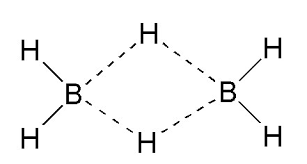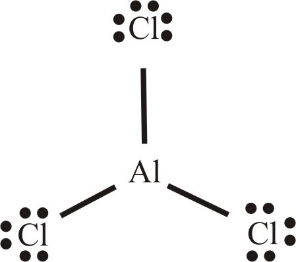
Which of the following has electron deficient compounds?
(A) ${B_2}{H_6}$, $AlC{l_3}$
(B) ${C_2}{H_6}$, $A{l_2}C{l_6}$
(C) $S{F_2}$, $C{l_2}O$
(D) $NaB{H_4}$, $ICl$
Answer
127.5k+ views
Hint: An electron deficient compound is the one in which there is an insufficient number of electrons to complete the octet of the central atom. These compounds contain insufficient numbers of electrons to form normal electron-pair bonds between each pair of the bonded atoms.
Complete step by step solution:
${B_2}{H_6}$ (Diborane) and $AlC{l_3}$ are electron deficient compounds. This is because:
In case of diborane, (as shown in the structure), each boron bonds with 4 hydrogen atoms.
But the valency of boron is 3 and each boron gives 3 valence electrons.
But in case of the 4th bond, there is no electron from boron’s side and hence making it electron deficient.

Now,
In case of $AlC{l_3}$ (as shown), Al atom bonds with $3$ Cl atoms. But it violates the octet rule. There are no bonds or lone pairs, which makes the surrounding electron count 8. It has only 3 bonds which makes only 6 electrons and hence making it an electron deficient compound.

Therefore, ${B_2}{H_6}$ and $AlCl{}_3$ both are electron deficient compounds.
Hence, option A is correct.
Note: Diborane is used in rocket propellants. It is also used as a rubber vulcanizer and a catalyst for olefin polymerization whereas aluminium chloride is used in the pharmaceutical industry. It is also used as an antiperspirant in products such as Drysol.
Complete step by step solution:
${B_2}{H_6}$ (Diborane) and $AlC{l_3}$ are electron deficient compounds. This is because:
In case of diborane, (as shown in the structure), each boron bonds with 4 hydrogen atoms.
But the valency of boron is 3 and each boron gives 3 valence electrons.
But in case of the 4th bond, there is no electron from boron’s side and hence making it electron deficient.

Now,
In case of $AlC{l_3}$ (as shown), Al atom bonds with $3$ Cl atoms. But it violates the octet rule. There are no bonds or lone pairs, which makes the surrounding electron count 8. It has only 3 bonds which makes only 6 electrons and hence making it an electron deficient compound.

Therefore, ${B_2}{H_6}$ and $AlCl{}_3$ both are electron deficient compounds.
Hence, option A is correct.
Note: Diborane is used in rocket propellants. It is also used as a rubber vulcanizer and a catalyst for olefin polymerization whereas aluminium chloride is used in the pharmaceutical industry. It is also used as an antiperspirant in products such as Drysol.
Recently Updated Pages
Difference Between Vapor and Gas: JEE Main 2024

Area of an Octagon Formula - Explanation, and FAQs

Difference Between Solute and Solvent: JEE Main 2024

Absolute Pressure Formula - Explanation, and FAQs

Carbon Dioxide Formula - Definition, Uses and FAQs

Charle's Law Formula - Definition, Derivation and Solved Examples

Trending doubts
JEE Main 2025 Session 2: Application Form (Out), Exam Dates (Released), Eligibility & More

JEE Main Login 2045: Step-by-Step Instructions and Details

JEE Main Exam Marking Scheme: Detailed Breakdown of Marks and Negative Marking

JEE Main 2023 January 24 Shift 2 Question Paper with Answer Keys & Solutions

JEE Mains 2025 Correction Window Date (Out) – Check Procedure and Fees Here!

JEE Main Participating Colleges 2024 - A Complete List of Top Colleges

Other Pages
JEE Advanced Marks vs Ranks 2025: Understanding Category-wise Qualifying Marks and Previous Year Cut-offs

NCERT Solutions for Class 11 Chemistry Chapter 7 Redox Reaction

NCERT Solutions for Class 11 Chemistry Chapter 5 Thermodynamics

NCERT Solutions for Class 11 Chemistry Chapter 9 Hydrocarbons

NCERT Solutions for Class 11 Chemistry Chapter 8 Organic Chemistry

NCERT Solutions for Class 11 Chemistry Chapter 6 Equilibrium




